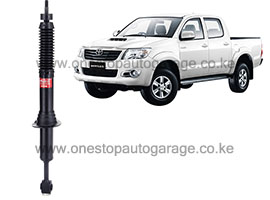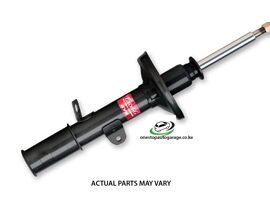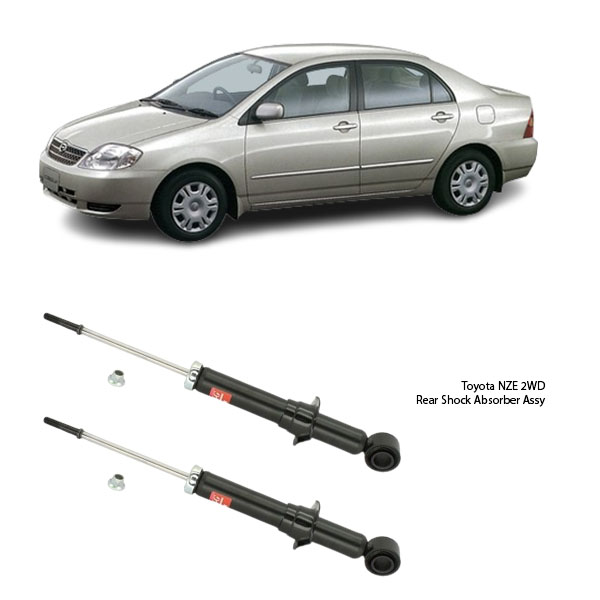-8%
Get Toyota NZE 2WD Rear shock Absorber Assy 341322 in Kenya
In Kenya’s diverse and often challenging driving environments—from city streets and pothole-ridden highways to rural dirt roads—the rear shock absorber assembly plays an essential role in delivering a smooth, safe, and controlled driving experience. It is one of the most crucial components in a vehicle’s suspension system and directly affects handling, comfort, safety, and even tire wear.
Understanding what the rear shock absorber assembly does, why it’s important, and how to maintain it is key for both vehicle owners and technicians across the country.
What is a Rear Shock Absorber Assembly?
The rear shock absorber assembly is a suspension component located near the rear wheels of a vehicle. Its main job is to control the rebound and compression of the suspension springs and to dampen the impact from road irregularities. Without shock absorbers, a car would bounce uncontrollably after hitting bumps, making driving extremely uncomfortable and unsafe.
A full assembly typically includes:
-
The shock absorber (damper) itself.
-
Mounting bushings and brackets for proper installation.
-
In some designs, it may also include a coil spring, particularly in coilover shock assemblies.
How It Works
When a vehicle hits a bump or pothole, the suspension springs compress and then expand. The shock absorber controls this motion by using hydraulic fluid or gas to slow down and regulate the spring’s movement.
In simple terms:
-
It absorbs the energy from road impacts.
-
Converts that energy into heat, which is then dissipated through hydraulic fluid.
-
Ensures the tires stay in contact with the road for maximum traction and control.
Why It’s Crucial in Kenya
Kenya’s road conditions are highly varied, and in many areas, less than ideal. That makes the rear shock absorber assembly especially important:
1. Rough Roads & Speed Bumps
From Nairobi’s urban traffic to rural paths, vehicles encounter countless speed bumps, potholes, and unpaved roads. Without functioning shocks, these daily obstacles can cause severe discomfort and damage.
2. Heavy Loads
Vehicles used for family, business, or transport purposes often carry heavy loads in the rear. This puts extra strain on the rear shocks, requiring them to be in top condition for safe operation.
3. Long-Distance Travel
Long drives between cities or to upcountry areas demand suspension components that can handle heat, friction, and constant motion over long hours.
Functions of the Rear Shock Absorber Assembly
-
Ride Comfort
By damping vibrations and impacts, rear shocks provide a smoother ride for passengers and protect the vehicle from excessive jarring. -
Handling and Stability
Rear shocks help keep the car stable during acceleration, braking, and turning—especially important when driving at high speeds or on uneven roads. -
Tire Contact and Wear Reduction
Shocks ensure that the rear tires remain firmly planted on the road, reducing uneven wear and extending tire life. -
Braking Efficiency
A good set of rear shock absorbers prevents excessive nose-diving during braking and improves stopping distance and control.
Signs of a Worn Rear Shock Absorber Assembly
Recognizing the early warning signs of shock absorber wear can prevent further damage and unsafe driving conditions. Common symptoms include:
-
Bouncing or swaying after hitting a bump
-
Unstable rear end when turning or changing lanes
-
Uneven or excessive tire wear
-
Fluid leakage from the shock housing
-
Longer stopping distances
-
Visible damage or rust on the shock absorber
-
Rear of the car “bottoms out” when loaded
When to Replace Rear Shocks
There’s no fixed interval for replacing shock absorbers. It depends heavily on:
-
Driving habits
-
Road conditions
-
Vehicle usage
However, in the Kenyan environment, where roads can be unpredictable, shocks typically need inspection every 20,000 to 40,000 kilometers, with replacements likely around 60,000 to 80,000 kilometers—sooner if heavily loaded or frequently driven off-road.
Types of Rear Shock Absorbers
-
Twin-Tube Shock Absorbers
These are common and affordable, offering reliable performance for everyday driving. -
Mono-Tube Shock Absorbers
Often used in performance or heavy-duty applications. They provide quicker response and better cooling. -
Gas-Charged Shocks
Use nitrogen gas to reduce foaming in the hydraulic fluid, improving performance and consistency. -
Adjustable Shocks
Offer customizable stiffness for performance or load-carrying needs. -
Coilover Shock Assemblies
Combine the coil spring and shock into one unit. These are popular in sports applications or upgraded suspensions.
Factors to Consider When Choosing Rear Shock Assemblies
When it’s time to replace or upgrade your rear shock absorbers, consider the following:
-
Durability and Build Quality
Invest in components made from quality materials to withstand Kenyan terrain. -
Compatibility with Vehicle
Ensure the shock assembly matches your suspension setup and fits perfectly. -
Driving Conditions
Choose heavy-duty shocks if driving in rural or off-road environments, or go for comfort-tuned versions for city use. -
Load Capacity
If frequently carrying heavy loads, consider shocks rated for higher weight support. -
Brand Reputation
Go for trusted names that offer warranty and have proven reliability in local conditions.
Benefits of Timely Rear Shock Replacement
-
Improved Driving Comfort
No more bumpy, harsh rides—just a smooth and quiet journey. -
Enhanced Safety
Better braking, steering, and road grip mean safer trips. -
Protects Other Parts
A worn shock can cause stress on springs, bushings, and even chassis components. -
Better Fuel Efficiency
A stable vehicle reduces unnecessary energy loss and improves fuel usage.
Maintenance Tips
To extend the life of your rear shock absorbers:
-
Inspect them regularly—especially after long trips or off-road use.
-
Avoid overloading your vehicle, which can prematurely wear out the suspension.
-
Listen for unusual noises from the rear—clunks, rattles, or squeaks may signal an issue.
-
Keep underbody components clean to prevent rust or dirt buildup on shock housings.
-
Have suspension alignment checked after replacing shocks to ensure optimal performance.
Final Thoughts
The rear shock absorber assembly is far more than just a comfort feature—it’s a safety and performance cornerstone. Especially in Kenya, where roads can throw constant surprises your way, ensuring that your rear shocks are in good condition is one of the smartest investments a car owner can make.
Routine checks, timely replacements, and using quality components tailored to your driving needs will ensure a smoother ride, a longer-lasting vehicle, and safer journeys—whether you’re navigating Nairobi traffic or heading off the beaten path.
Follow us on Facebook for more parts.



